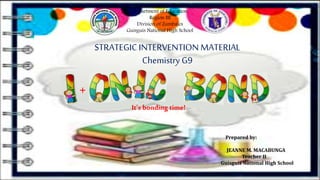
Strategic Intervention Material in Science 9: I+o nic bond
- 1. Department of Education Region III Division of Zambales Guisguis National High School It’s bonding time! Prepared by: JEANNE M. MACABUNGA Teacher II Guisguis National High School STRATEGICINTERVENTION MATERIAL Chemistry G9 +
- 2. GUIDE CARD 1 Explaining the formation of ionic bond Least Mastered Skill: Sub-Tasks: o Identify the metallic and non-metallic elements o Determine the electronegativity difference of the given atoms o Write the Lewis symbol of the given elements
- 3. An ionic bond is the electrostatic force holding two oppositely charged ions together. An ionic bond forms when a transfer of electrons takes when a transfer of electrons takes place between atoms. between atoms. Metals have low electronegativity and ionization energy, thus and ionization energy, thus they tend to transfer or loose electrons. Non-metals transfer or loose electrons. Non-metals have high electronegativity and Are you ready? Turn on the next page… IONIC BONDDo you know what kind of element forms cation and anion after ionic bonding? Do atoms attain stability after ionic bonding? You will gain information about chemical bonding that involves gaining and losing electrons as you explore the ions with my adventurous surprises. GUIDE CARD 2
- 4. Li & F Na & K K & O H & Cl Na & Cl ACTIVITY CARD 1 Choose 3 pairs of metallic and non-metallic elements from the following. Write your answers on the space provided below. Pair Buddies 1. _____________________ _______ 2. _____________________ _______
- 5. ACTIVITY CARD 2 Refer to the Periodic Table of Elements for the electronegativity values. Subtract the electronegativity values of the metallic element from the non-metallic element. Encircle the pair/s of elements if the difference is greater than 1.9 wherein complete transfer of electron/s is possible. More or Less? 1. Na and Cl 2. Na and K 3. Li and F 4. K and O 5. H and Cl
- 6. ACTIVITY CARD 3 Dots interesting! Write the Lewis Symbol of the given elements. 1. Na and Cl 2. Li and F 3. K and O Since bonding involves the element’s valence electrons, Lewis symbols are used. Lewis symbols consist of the element plus a dot for each valence electron Forexample:
- 7. ACTIVITY CARD 4 With the use of an arrow, show the complete transfer of electron/s and indicate the formation of ions. Shot me with an arrow… You’re now ready for the next challenge… Metals form cations _ _
- 8. 1. A metallic element forms anion after ionic bonding. 2. Ions are formed after an ionic bonding. 3. Chlorine is a metallic element. 4. Sodium and chlorine will result to ionic bonding. 5. Anon-metallic elementforms anion after ionic bonding. ASSESSMENT CARD 1 True Colors Color the star with red if the statement is true and blue if it is false.
- 9. 1. B & Cl 4. Be & F 3. K & Cl 2. Ca & I 5. Li & O ASSESSMENT CARD 2 Based on the electronegativity difference between the given atoms, identify which of the following pairs of atoms will result to ionic bonding. What’sthe Difference? Refer to the Periodic Table for the electronegativity values.
- 10. FN Na Ba S Mg Ionic BondGo Fishin’… Catch the fish and make 5 combinations that will result to ionic bonding. Write the elements’ symbols on the boat. ENRICHMENT CARD 1 1. ___________________ 2. ___________________ 3. ___________________ 4. ___________________ 5. ___________________
- 11. ENRICHMENT CARD 2 5. Potassium Bromide Compound Metallic element Non-metallic Element 1. Calcium Chloride 2. Beryllium Oxide 3. Barium Iodide 4. Magnesium Sulfide Identify the metallic and non-metallic elements present in each ionic compound. What is it made of?
- 12. REFERENCE CARD G9 Science Learner’s Material pp.113-119 G9 Science Teacher’s Guide pp.14-18 Villamar Jr., Rufino A., Chemistry. Quezon City: St. Bernadette Publishing House Corporation. C2004. pp 86-91 Try to readfurther…
- 13. ANSWER CARD 1 Na & Cl K & O ACTIVITY CARD 1 ) ) ) 3.0 – 0.90 = 2.10 4.0 – 1.0 = 3.0 3.5 – 0.8 = 2.7 ACTIVITY CARD 2 ACTIVITY CARD 3 - - + - + ACTIVITY CARD 4 Na (EN=0.90) Cl (EN=3.0) K (EN=0.8) O (EN=3.5) Li (EN=1.0) F (EN=4.0) + +
- 14. Metallic element Non-metallic Element Calcium Chlorine Beryllium Oxygen Barium Iodine Magnesium Sulfur ANSWER CARD 2 1 2 3 4 5 ASSESSMENT CARD 1 ASSESSMENT CARD 2 ENRICHMENT CARD 2ENRICHMENT CARD 1 1. 3.0 – 2.0 = 1.0 2. 2.5 – 1.0 = 1.5 3. 3.0 – 0.8 = 2.2 4. 4.0 – 1.6 = 2.4 5. 3.5 – 1.0 = 2.5 Mg and F Na and N Na and F Ba and N Ba and F Metallic Element Non-metallic Element Calcium Chlorine Beryllium Oxygen Barium Iodine Magnesium Sulfur Potassium Bromine
- 15. How welldid you learnfrom this lesson? I fullyunderstandthe concepts and theirapplications. I partiallyunderstand theconcepts and their applications. I stilldonot understandtheconcepts and their applications. STUDENT’S NOTES